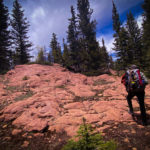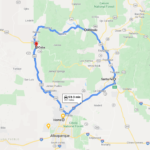A recent visit to the the San Pedro Parks Wilderness highlighted the incredible complexity of the geology of New Mexico. Follow highway 550 from Albuquerque up to a high desert plateau at Cuba, NM and one passes through hundreds of millions of years of geologic history, exposed in a kaleidoscope of colors and shapes. Exit 550 to highway 96 heading east to the wilderness access we chose to visit and the wonders continue. A quick glance at Google Earth images of the area around the wilderness leaves one perplexed at how such a melange of rocks could be put together in one place.
A few miles to the east of the wilderness, one of the largest super-volcanoes, (the Valles Caldera) in the United States covered the surrounding area with ash and lava. Another giant volcano protrudes into the desert sky west of here. Both of these are visible from the top of the SPPW. Here, between what must have been a violent battlefield of volcanic eruptions, the pink granite you see here in the picture was quietly uplifted to over 10,000 feet in elevation through an overlying layer of sandstone, limestone and chalk that was previously deposited by an ancient sea. Outcroppings of quartzite are common and interspersed in the granite. Quite different from the surface geology of the surrounding volcanic features.
Interestingly, the sedimentary layers of sandstone and limestone seem relatively constant throughout the area. Here in the wilderness, the granite protruded through those layers as if trying to defy gravity and reach for the sun. Older rock pushes up through younger rock. In adjacent areas previously mentioned, volcanics erupted and broke through the sedimentary layers and then capped them, here covering the ancient sea beds. Erosion of the younger volcanic basalt leaves black capped mesas all around that are buttressed by the older multicolored seabed layers below.
Obviously, this is an oversimplified explanation of what’s happening here but a more detailed and technical analysis of the areas geology is presented in this REPORT if you are inclined to read it. But, for most of us, it’s enough to observe and wonder about these rocks of the desert west as the complex makeup of the ground below us is laid bare and put on display for us to enjoy.
On our journey, we drove 300 miles in a loop around the SPPW and the Valles Caldera and walked 22 miles over 3 days in the wilderness. As we drove, walked and camped, time spent contemplating and trying to imagine how these rocks found themselves in their current state is one the joys of living in New Mexico and exploring, more broadly, the American west.


